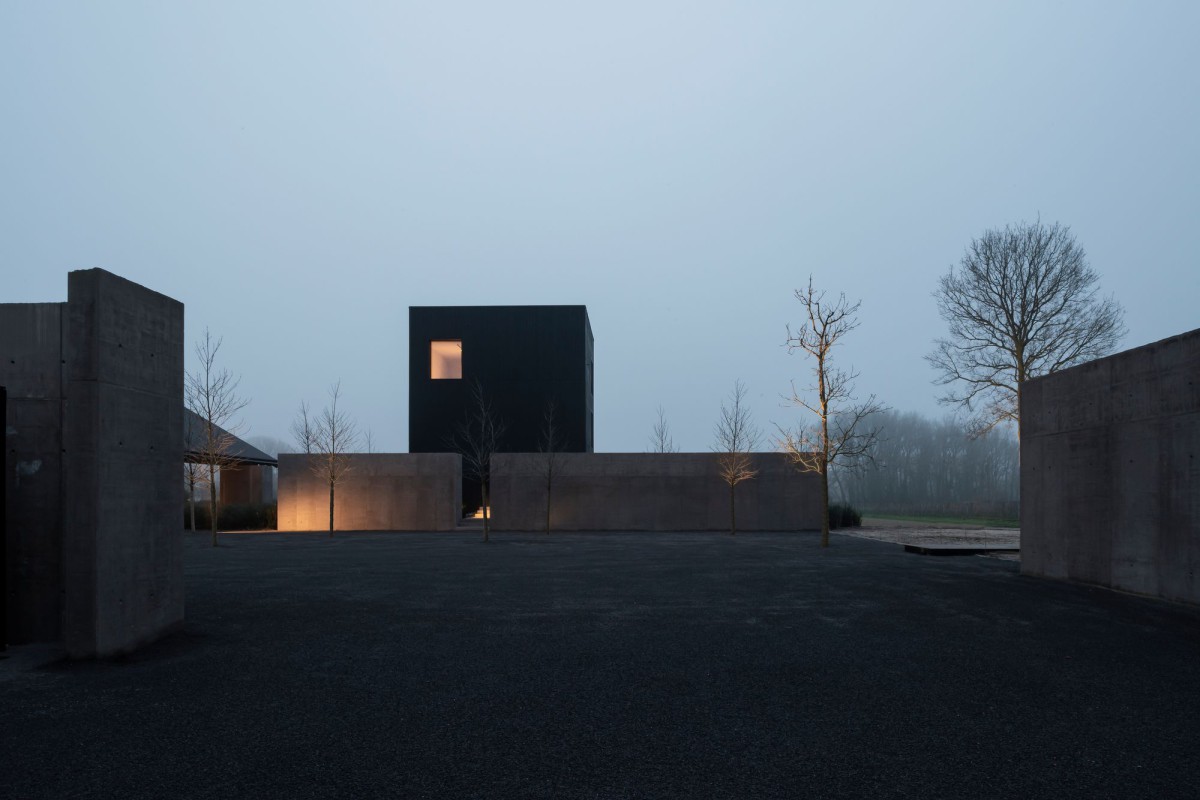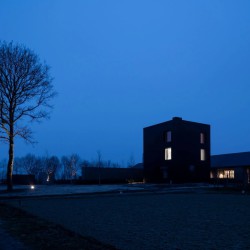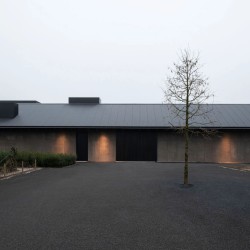Vincent Van Duysen . photos: © Koen Van Damme
Liezele, a small hamlet 30 minutes south of Antwerp, is a fertile area where small agricultural farmsteads are traditionally growing asparagus, were green fields, small streams, aligned with rows of willow- or poplar trees are defining the structure and mood of this beautiful rural Flemish landscape.
“Valcke Vleug”, the small stream/brook dividing and giving the name to the VV winery, is “the flight of the Falcons” in old days typical birds in the area, an illustration of the rich natural beauty, an illustration of the character of the place. It’s this character on this specific location, close to the owners’ house, that starts the building of a once in a lifetime project’: a hedonistic estate that allows to grow 4,2 hectares of cool climate wines, to enjoy horse-riding in nature, and enjoy life and culture in all its aspects with family and friends.
The architecture by Vincent Van Duysen is embedded in the same tradition of Flemish Farmsteads, archetypical in its form and sturdy functional in its setting, the same building elements were part of the demolished asparagus farm on the site, but also have been an integral part of the rural heritage for centuries before. The horizontal grand barn, typical for the traditional farm buildings is now combined with a small but vertical modern farmhouse and together they create a new hierarchy which dialogues with the strong horizontal lines in the open landscape.
The barn and the tower are the protagonists of the place and are defining, together with 4 massive concrete volumes, the central court, the heart of the winery, where all activity of Valcke Vleug Estate finds a place. An open-air empty square that gives hierarchy and organizes the farm, a place to gather the grapes during harvest or linking the wine tasting functions with the natural surroundings, the core of the project that allows for events or for quiet moments when the farmer, after a hard day at work, enjoys sunset when resting on the long wooden bench.
The benches, designed by Daniel De Belder, are part of embedding the grand architectural volumes to the human scale, even if the benches are sometimes 8 meters long, they feel in proportion and are creating ‘moments’ in the overall architectural project where the hedonistic, yet the sober experience is taking over. It seems that the massive wooden elements of De Belder work together with the architectural volumes of Van Duysen to maximize the experience of the visitor towards the landscape, to link the building’s position to the Valcke Vleug stream, and to relate the old magnificent oak close to the house, to organize the orientation towards the best sunset views, etc. … but as a matter of fact, it is the other way around, the project embeds to the natural beauty and by adding more than 50 newly planted poplar, willow, cherry and hazel trees it gives proof of the intention of the long-term integration of the new farm in its natural setting.
The color of the terroir, the soil of Valcke Vleug has inspired the selection of the lava stone soft scaping of the access roads and central court. This is an important aspect, the border between winery soil and functional soft scaping of the farm is invisible and the color tone continues into the concrete foundation, floors, and walls. It seems that the architectural volume is part of its natural character of the soil (so important for the ‘terroir’ winemakers are referring to), it allows a continuation between the soil and the architectural, between the indoor and outdoor spaces, with only the metal-clad black wooden roof structure above.
The same black-colored wood of sustainable European Larch is used for the shutters of the barn and the cladding of the farmhouse. The black color refers to the “Flemish Barns” traditionally painted in coal tar to protect wooden structures for a long time. A tradition of color that adds contrast to the green lush surroundings and giving the projects its sharp, edgy contemporary character.
The farmhouse and its private life are protected behind the concrete walls at the central court. The rooftop terrace gives a view of the far surroundings, overviews the farmstead activity and the winery beyond. This experience is in all rooms part of the private life, window bays give light and view, also at living room level where the ground floor is softly raised, just above 1 meter, to emphasize the experience of the owner, a long-distance perspective on the strong horizontal landscape created by the 17.000 vines. This is an experience that relates the manmade farmland geometry with the beauty of the architectural form of volumes and into the sharp lines of its interiors.
The interior spaces are a continuity of the architectural language, the rough concrete floors are functional and yet warm sober at the same time, the open structural black wooden roof structures seem to merge into black wooden wall cladding, furniture, and grand open fires, all elements creating spaces where wine tasting feels protected in an open shelter or where the wooden or stainless steel wine barrels are waiting for the next generation of Valcke Vleug wines to come.
_



































































